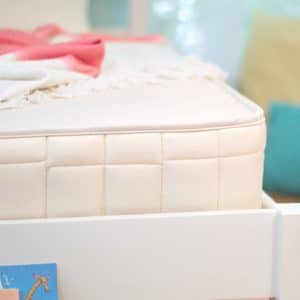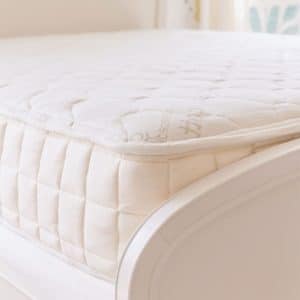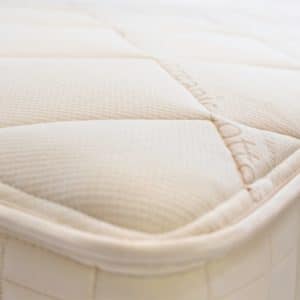Organic Kids Mattress – A Guide to Choosing the Best Organic Mattress for Kids

One of the most important decisions a parent can make is choosing the best mattress for kids, and more importantly – an organic kids mattress.
In shopping for an organic kids mattress, price and comfort may be your top priorities. But did you know that even organic mattresses can have toxicity issues?
Since your kids spend more than one-third of their lives in direct exposure from their mattress materials, it’s crucial to their health that those materials be organic AND non-toxic.
Sleep is critical to your child’s health and wellbeing.
A safe, non-toxic organic mattress can help your child sleep better. Kids are more vulnerable to the toxins in mattresses since their fragile organ and elimination systems are developing and they can’t easily detoxify. During sleep, children’s bodies work to recover from the accumulation of toxins and stress from their day. The cells attempt to regenerate, and the body tries to eliminate toxins. The last thing you want to do is interrupt healthy sleep by introducing more toxins from your child’s mattress.
Kids are vulnerable to the chemical exposure from mattresses for these reasons:
- They spend a lot of time sleeping
- Their fragile systems are developing
- They cannot easily detoxify
- Bedtime is for regeneration and recovery
Let’s look at each of these factors:
They spend a lot of time sleeping
Kids can spend between 7 and 12 hours every day on a mattress. During this time, they breathe in chemical off-gassing and absorb toxins through their skin. It’s an up-close, ongoing, long-term exposure.
Their fragile systems are developing
Children’s respiratory, neurological, reproductive, and immune systems are in the early stages of development. This makes them more vulnerable to toxic chemicals. Of particular concern is brain development – low level chemical exposure during the critical period of brain development can cause more harm than high doses later in life.
They cannot easily detoxify
When exposed, kids cannot easily detoxify and excrete these toxins, since their elimination systems are still developing.
Bedtime is for Regeneration and Recovery
While sleeping, children’s bodies need to recover from the stress of the day. The cells regenerate and the body attempts to remove toxins. It’s difficult to do this while breathing and absorbing more toxic chemicals from the mattress.
What’s In a Typical Kids Mattress?
These elements can be present in a typical kids mattress:
- Toxic Foam
- Fire Retardant Chemicals or Barriers
- Toxic Glues
Here’s an in-depth look at what those elements mean for your kids mattress:
Toxic Foam
Polyurethane foam is the most common mattress filling, and this is made from petroleum with various chemical additives. Since foam is flammable, flame retardants are either added to the foam or used in a barrier around the foam. Toluene diisocyanate and methylene diphenyl diisocynate are isocyanates usually used as primary building blocks of foam and mixed with water and polyols. Toluene is a known carcinogen and exposure to isocyanates can irritate mucous membranes and cause asthma, respiratory disease, skin inflammation, and chemical sensitivity.
Foam breaks down over time into small particles, which can become airborne. Multiple VOC emissions have been identified in foam mattresses that can be inhaled and absorbed into the body. Memory foam mattresses contain even more potentially harmful chemicals – to make the foam malleable.
Think carefully before buying foam mattresses for your kids’ beds. Many kids (and adults) are sensitive to these chemicals and can end up getting very sick. If that happens, you’re stuck with an expensive mattress that you can’t return.
Fire Retardant Chemicals or Barriers
Since mattress manufacturers are required to meet government flammability regulations, they add fire retardant chemicals or barriers that can be toxic, including brominated, chlorinated, organohalogen flame retardants, antimony, modacrylic, polyacrylonitrile, boric acid and many other chemicals. PBDEs have recently been banned, but have been replaced with chemicals that can be just as toxic.
Some flame retardants are not heavily bound and can migrate from the mattress into the air and into household dust. They then become stored in our bodies and children are most at risk.
Flame retardants have been linked to these health issues:
- lower IQ
- hyperactivity
- thyroid dysfunction
- altered sexual development
- early onset of puberty
- developmental issues
- cancer
Consumers are in the dark about what chemicals are used in the mattresses they are buying. Formulations are considered trade secrets and not disclosed. Even when the company says “no added flame retardants” it does not mean there are no flame retardants in the barriers or the foam they use. They might say “no added flame retardants” because they didn’t add them, but the flame retardants were likely already added by the manufacturer of the materials they used in making the mattress. Since polyurethane foam is highly flammable, chemicals must be used so the mattress can pass government fire standards.
Toxic Glues
Another issue with mattresses are the glues or adhesives used. In particular, if the mattress (even organic/green mattresses) contains individually encased coils, they are all connected with glues that may be toxic. A lot of glue can go into a mattress with individually encased coils. To date, the only manufacturer we know that heat seals all the encased coils is Naturepedic. Naturepedic does not use any glues or adhesives anywhere in any of their mattresses.
Be Aware! Older Mattresses can be Toxic too!
Since the chemicals never completely dissipate, older mattresses may continue to off gas even though they no longer contain the chemical smell. There is evidence that common bacteria and fungus in re-used, older mattresses can generate a higher concentration of toxic gases than new mattresses.
Alternatives to Toxic Mattresses
Your kids don’t have to sleep on poison! Fortunately, organic mattresses made with safe materials are available. Some organic mattresses for kids meet or exceed flammability regulations with safe, non-toxic materials.
Here are some things you need to know to choose a safe organic kids mattress:
Choose an Organic Kids Mattress with Non-Toxic Materials for Your Child’s Bed
Yes, an organic kids mattress is definitely important, but it’s even more important to ensure that ALL the materials used are non-toxic and there are no harmful fire retardants or barriers.
Organic Cotton
Cotton is firm and breathable. 100% certified organic cotton is a perfect filling for a child’s mattress. It’s also the best covering or surface ticking material, especially when it’s quilted.
Natural Latex
Natural latex can also be a safe material, depending on how it’s made. Latex comes from the milky substance of the rubber tree plant. If you are going to use latex, make sure it’s all natural latex, preferably organic, and stay away from chemical/natural latex blends. If you can find GOLS certified organic latex, you know you are getting the purest natural latex available.
Wool
Wool is also used in organic mattresses. Wool is a safe, non-toxic material when it’s organic or processed according to organic standards.
Eco Foam, Bio Foam or Soy Foam – Beware!
Some mattresses are marketed as green, eco-friendly, or plant-based with descriptions such as Eco Foam, Bio Foam, or Soy Foam. Beware of these since the manufacturers replace only a small percentage of the polyurethane foam with plant-based ingredients. For instance, soy foam is usually polyurethane foam with 10-20% soybean oil (GMO) mixed in.
These mattresses are mostly polyurethane foam, which is highly flammable, so they also need fire retardant chemicals to comply with the flammability laws. Don’t be fooled by this green-washing. You’re still getting a load of toxic chemicals and off-gassing with many of these so-called eco mattresses.
GOTS Certification
It’s important to check into all materials used, and it can be difficult to get full disclosure from the retailers or the manufacturer. Look for organic mattress and bedding companies who are GOTS certified. The Global Organic Textile Standards (GOTS) are the trusted organic textile processing standards for mattresses. The standards require that fiber and fabrics used within a mattress, with limited exceptions, must be made from National Organic Program (NOP) certified materials and processed in accordance with the Global Organic Textile Standard (GOTS). All other components (such as innersprings, fire protection, etc.) must meet strict non-toxic standards.
A common practice is to borrow a GOTS logo from a supplier. The mattress manufacturer might use an organic fabric from a supplier that is GOTS certified. But if the mattress manufacturer is not certified, and they simply use GOTS certified cotton, then this is not a certified organic product and it may contain toxic components.
Non Toxic Natural Fire Protection
Always ask the manufacturer or retailer for complete details about what they use to pass fire standards. Retailers cannot legally sell mattresses without fire protection, unless you have a doctor’s prescription for a chemical-free mattress.
There are safe alternatives to chemical fire retardants that will allow a mattress to pass flammability standards. Some manufacturers use wool since it has flame resistant properties. There are companies that use only pure wool for this purpose, but some companies use wool with chemical treatments added to boost the wool’s fire resistance.
PLA fiber (made from plant starch) is flame resistant and a safe alternative. PLA fiber is non-toxic, hypoallergenic, and performs well in the wash. Make sure the PLA is free of GMOs.
Choosing the Best Organic Mattress for Kids
The way to ensure a non-toxic sleep environment is to avoid polyurethane foam, memory foam and other synthetic materials. Also avoid mattresses with fire retardants. Your kids need a mattress with good quality organic, non-toxic materials.
In this next section, we take a look at:
- Firm vs Soft Mattress
- Natural Latex vs Coils
Firm vs Soft Mattress for Kids
Trying to decide between a firm vs soft mattress for kids? Kids generally need firm support for postural alignment when they are young. A kids organic mattress that is too soft might lead to improper spine alignment, which could cause posture and back issues. A good comfort level for a kids mattress is firm or cushion firm, which means the organic mattress is supportive and firm with some cushion for comfort. Good postural and spinal alignment is not simply about firmness but whether a mattress distributes weight properly (see the section below on individually wrapped coils).
As they grow older, kids may begin to prefer a softer mattress, but this is always a matter of preference. It’s best to begin with a firm mattress since you can always add a soft topper as your child grows older. You can always make a firm mattress softer, but if you start out with a soft mattress and find your child needs more support, there’s not a lot you can do.
Natural Latex vs Coils
Should you get an organic kids mattress with metal coils or innersprings?
There’s a popular belief that the metal in a mattress acts as an antenna to attract and amplify EMFs. I’ve extensively looked into this, and there is not enough evidence to this assumption. The misunderstanding comes from a blog post that provided speculation about innerspring mattresses, which was not based on fact. In actuality, the authors of the study that is supposed to make this claim actually say that metal in a mattress has a weakening or attenuated influence on EMFs. Even so, the conclusions of this study are continually misrepresented. EMFs are definitely something to be concerned about, especially in the bedroom since they can interfere with sleep. It’s important to keep electronics, cell phones, etc out of your child’s bedroom. If you’re still concerned about metal in a mattress, avoid innersprings that are connected with metal helicals and get encased coils that are individually wrapped in fabric. Or buy a mattress with a natural latex core.
Support Layer of an Organic Kids Mattress
The support layer controls how deeply the heavier parts of your body sink down into a mattress. It also helps the comfort layers hold up the more recessed parts of the body when necessary.
Innersprings
An innerspring organic kids mattress has a completely different support layer than a mattress with individually wrapped coils (also called encased or pocketed coils). Traditional innersprings are continuous coils that are connected with metal helicals. Innerspring mattresses are usually less expensive since they are easier to make. However, a good quality innerspring will last a long time. Innersprings can provide a firm support to a mattress but they have less ability to provide body contouring like individually wrapped coils. Therefore, they might be less comfortable.
Individually-Wrapped Coils
Individually wrapped (encased) coils are enclosed individually in a cloth material, creating separate pockets that function and move independently. The independent coils feel a little more buoyant while relieving pressure on the joints. They provide individualized comfort by cradling and conforming to the body. The wrapped coils are more responsive to your child’s weight and movements than traditional innerspring mattresses, so your child gets balanced back support. This results in less tossing and turning. Wrapped coils also provide airflow to reduce overheating.
In addition, you don’t get the transfer of motion you get with an innerspring. Individually-wrapped coils are great for adults that don’t want to be disturbed every time their partner moves. And if you lie down with your child on their encased coil mattress until they fall asleep, as many parents do, you are less likely to disturb your child when you leave the bed.
Individually-wrapped or encased coils provide more comfort, better weight distribution and support than an innerspring. There are only a couple of drawbacks – they are more expensive and many companies use toxic glues to hold the pockets together.
Latex Support Core
Natural Latex comes from the milky liquid from a rubber tree. The liquid is harvested and then baked into a foam. Latex is an extremely durable mattress material, and will easily outlast polyurethane foam, which breaks down over time. A good quality latex support core will last over 20 years – throughout your child’s childhood and beyond.
Latex is resilient, with a tendency to spring back to its original position and adjust to different body weight and sleeping positions. Latex is able to maintain its comfort for a long time without body impressions or sagging. And as with pocketed coils, you don’t get the motion transfer like you do with innersprings.
Latex is an expensive material, but it can be combined with coils within a support layer, which can make it more affordable. It also weighs more than most mattresses. If you’re concerned about latex allergies, then choose a mattress with individually-wrapped coils instead of latex.
You need to be careful that you are getting quality natural latex and not a synthetic blend. A mattress can be labelled as a natural latex mattress even if it only has about an inch of latex. Latex can also be made synthetically from a chemical called styrene butadiene, and you definitely want to avoid that. Synthetic is a lot less expensive than natural latex, but it’s not a healthy alternative.
Latex certified to the Global Organic Latex Standard (GOLS) means that all latex sap comes from certified organic rubber plantations. This certification also ensures fair labor practices and a reliable trustworthy supply chain.
Comfort Layer
When discussing a comfort layer for an organic kids mattress, the only thing I will mention about polyurethane foam (especially memory foam) is to avoid it. These are not safe materials for kids (or adults) since they are made with toxic chemicals that can off-gas.
Latex, organic cotton, or individually wrapped microcoils make excellent comfort layers for an organic kids mattress.
- Organic cotton is a safe, non-toxic material that provides a breathable, firm comfort layer. It’s important that the cotton be GOTS certified.
- Microcoils are miniature versions of individually wrapped coils and are used in some mattresses as a comfort layer. Microcoils will gently push back and support the body really well. The coils are tiny so you won’t feel them, and they form a slight cradle, contouring to the body to relieve pressure points. Another great quality of microcoils is that they provide excellent breathability.
- In addition to being a great choice in a support core, natural latex can make an excellent sleep surface. Latex provides a cooler sleep surface than synthetic foam and can provide a somewhat similar feel to memory foam without the toxicity. A latex topper is also a great choice for a super firm mattress that might need more cushion. However, if you have any allergy concerns with latex, you might want to choose organic cotton or microcoils for your child’s sleep surface.
Which Organic Kids Mattress is Right for Your Child?
All the mattresses you find here at Healthy Child have been thoroughly evaluated and vetted to be safe, non-toxic and free from harmful substances. These mattresses are an important investment in your child’s health and are designed to keep your child safe, comfortable and provide a healthy sleep environment throughout childhood and beyond.
Here’s the rundown on each one so you can choose the best mattress for kids.
Naturepedic 2 in 1 Organic Kids Mattress
Perfect for training toddlers and bed wetters! Use the waterproof side while potty training. The waterproof side also functions as a dust-mite and bed bug barrier. When your child gets older, you can flip the mattress over for a more grown up, quilted organic cotton surface throughout the childhood years.
- Excellent for first big kids bed and throughout childhood
- Lowest priced organic mattress
- No need to buy multiple mattresses as your child grows
- 2-sided mattress
- One side is waterproof for easy clean-up
- Waterproofing is made from non-GMO sugar cane
- One side is quilted organic cotton surface
- Entire mattress is GOTS certified
- No glues or adhesives
- No wool or latex, making it perfect for vegans or those concerned with allergies
- Firm support – great for kids for proper postural alignment
- Can add topper later if need more pressure point relief
- Sizes: Twin, Twin Trundle, Twin Trundle Short, Full
- Trundle sizes are great for bunk beds and trundle beds
- Ships compressed and roll packed for easy delivery and set up
- 30-day money back return
View 2-in-1 Organic Kids Mattress
Naturepedic Verse Organic Mattress
The Verse has individually-wrapped coils that promote airflow to reduce overheating, while promoting balanced support for proper postural alignment. Certified organic cotton filling provides additional cushion and support over the premium encased coils for a comfortable, supportive mattress.
Individually-wrapped coils provide isolation of movement, so if you lie down with your child on the Verse mattress until they fall asleep, as many parents do, you are less likely to disturb your child when you leave the bed.
- Great for younger children as well as teens and into adulthood
- Add a waterproof pad to protect mattress from accidents
- A firm, comfortable mattress for adults too
- Firm support – great for kids for proper postural alignment
- Quilted Surface with organic cotton and wool
- Premium encased coils provide comfort and some pressure point relief as your child grows
- Entire mattress is GOTS certified
- No glues or adhesives
- Sizes: Twin, TwinXL, Full and Queen
- Ships compressed and roll packed for easy delivery and set up
- 30-day money back return
Naturepedic Chorus Organic Mattress
The Naturepedic Chorus Organic Mattress offers everything you need in an organic mattress for the whole family! It was designed with a universal cushion-firm feel that is ideal for most people. The Chorus has a high-density layer of individually wrapped microcoils over premium encased coils to prevent body impressions, promote airflow, dissipate heat, and provide comfortable, supportive pressure point relief.
Individually-wrapped coils are great for adults that don’t want to be disturbed every time their partner moves. It’s the perfect mattress for a family bed and an excellent mattress for your child to grow on! And if you lie down with your child on their Chorus mattress until they fall asleep, as many parents do, you are less likely to disturb your child when you leave the bed.
- Increased comfort with greater pressure point relief
- Comfortable design that keeps you cool
- More comfort, better weight distribution and support
- For children and adults
- Cushion-firm support for those who need more pressure point relief
- Comfortable Medium-Firm Support with Two Layers of Premium Coils
- GOTS certified organic wool
- Entire mattress is GOTS certified
- No latex
- No glues or adhesives
- Ships compressed and roll packed for easy delivery and set up
- Sizes: Twin, TwinXL, Full, Queen and King
- 10” depth
- 30-day money back return
What does Healthy Child Recommend?
We’ve spent 22 years researching and finding the safest and healthiest kids mattresses and suggest that no matter which of the above mattresses you choose, you can rest easy knowing that your child is sleeping on the safest, non-toxic materials.
Organic Twin Mattresses
Our organic twin mattress recommendations offer a great choice for a child’s first ‘big’ bed and also for children of all ages as every mattress we recommend is organic and non-toxic. Each kids twin mattress listed here also provides comfort and proper support for growing children.
Our recommendations also provide a great solution for bunk beds with the Naturepedic 2 in 1 Organic Kids Mattress. The 2 in 1 is the only mattress we recommend that has a Trundle option. The 2 sides increase the lifespan of the mattress because it can be flipped over and both sides can be used for sleeping.
If you are looking for the best twin mattress for kids that can also serve as a guest bed that adults may be sleeping on, we would recommend the Verse mattress, which is cushion firm but has encased coils that provide some pressure point relief for heavier children and adults.
If you are likely to co-sleep with your child we would recommend the Chorus, Serenade or EOS mattresses as they all have larger sizes.
All of the Naturepedic organic mattresses come with a 25-year warranty. So will last through childhood and beyond.





Very good info, however I think you should update it to include more info about fiberglass. I had to buy a mattresses for my kid when she outgrew her crib and I was surprised to learn that many memory foam mattresses have fiberglass in them! The fiberglass is in loose strands and only contained by the manufacturer’s slipcover and after it gets released it goes into hvac systems and people have had to get rid of their homes or have them gutted to get rid of all the fibers!
Thank you very much for sharing these ideas. I really appreciate your efforts for creating this exceptionally well content. I was looking for such content about mattress you have really helped me with the same… great post!!
REPLY
Thank you for this article, we actually have a Naturepedic queen mattress and now we’ll definitely choose one of their organic mattresses for our baby. The quality is fantastic, they’re durable and low-maintenance.
This is great information! Helps convince those that think an organic mattress for a child is a waste of money. I am for sure doing an organic mattress for my son. Thank you!!!!